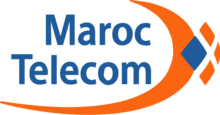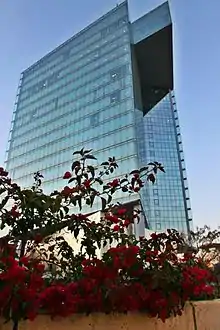Maroc Telecom
Maroc Telecom (Acronym: IAM, Arabic: اتصالات المغرب) is the main telecommunication company in Morocco. it's the largest telecom company in Morocco.
 | |
| Type | Public |
|---|---|
| Euronext: IAM | |
| Industry | Telecommunications |
| Founded | February 3, 1998 |
| Headquarters | Rabat, Morocco |
Key people | Abdeslam Ahizoune, Chairman & CEO Laurent MAIROT, CFO |
| Products | Landline phones, Mobile phone lines, Fiber-optic Internet, ADSL, 4G+ |
| Revenue | |
| Owner | Etisalat (53.09%) Moroccan government (30%) |
Number of employees | 10,609 (2018) |
| Website | http://www.iam.ma |

IAM employs around 11,178 employees. It has 8 regional delegations with 220 offices present on all the territory of Morocco. The company is listed on both the Casablanca Stock Exchange and Euronext Paris.
History
In 2006, the company reported a turnover of $2.67 bn. The custom base was established at 1.27m lines for the landline and at 391,000 lines for the ADSL.[1]
From postal services to telephony
The acronym IAM of Maroc Telecom comes from its original Arabic name Ittisalat Al Maghrib.[2] The name "Maroc Telecom" was adopted later for better international recognizability.
The origin of a Moroccan telecommunication project dates back to 1891 when Sultan Hassan I created the first Moroccan postal service. In 1913, the Moroccan Postal Telephone and Telegraph was established before a Dahir (King's decree) related to the monopoly of the state of Telegraphy and Telephony was published.
Telephony
In 1967, Morocco placed the first underwater cable between Tetouan, Morocco, and Perpignan, France, through the Mediterranean. A few years later, in 1970, a transmission via INTELSAT was introduced. The Telex service was then automated in 1971 just before installing a digital center in Fes.
Due to the advancement of telecommunications around the globe, Morocco decided to create a new entity called the Office National des Postes et Télécommunications (ONPT) to manage the industry. ONPT was responsible of the introduction of Analog Mobile Radiotelephony in 1987. Later on, in 1992, Morocco set up the first underwater optical fiber cable. Two years later, a GSM service was operational.
Internet
The Internet was introduced in Morocco by ONPT in 1995. In 2016, Maroc Telecom introduces fiber optics to the country with speeds up to 200 Mbits/s.
The birth of IAM
After the publication of a telecommunications' decree, Maroc Telecom (IAM) was founded in 1998.
Privatization
On 20 February 2001 the Moroccan government sold 35% of Maroc Telecom's shares to French mass media company Vivendi. The transaction amounted to 23 Billion dirhams.[3] On 4 January 2005 Vivendi acquired an additional 16% for 12.4 billion dirhams raising its participation to 51%.[4] In October 2007, the CDG ceded, via its subsidiary Filpar Holding, 2% of Maroc Telecom to Vivendi in exchange of 0.6% of Vivendi's shares, putting the total shares owned by Vivendi to 53%.[5]
Activities
IAM has three main activities:
Land lines
It consists of the provision of public phones throughout Morocco. The fixed park reaches 1.6 million lines.
Mobile phones
Mobile services are provided via a GSM network. Maroc Telecom counted 33 million customers at the end of October 2012. Its network covers 97% of the Moroccan population. It also has 12.5 million customers in Mali, Gabon, Burkina Faso and Mauritania. It is one of the most profitable phone operators in Africa with a revenue of 2.2 billion euros during the first 9 months of 2012.[7]
Maroc Telecom launched 4G+ in Morocco on July 13, 2015,[8] to negative reception because of low internet connection speeds not living up to the alleged 4G standards.
Customer support
Customer support does only propose contacting by phone to a special number and not via a contact form like most of telecommunication companies.[9]
Projects and investments
On June 1, 2006, IAM launched the IPTV package deployed by Huawei Technology[10] via the ADSL line. The service was the first of its kind in Africa and the Middle East.
In July 2006 Maroc Telecom signed with the French telecommunications equipment company Alcatel a contract for a submarine cable network connection between Morocco and France. Morocco Telecom's aim is to upgrade the capacity of its services (i.e.broadband services, call centers...). The project cost € 26 million and was named "Atlas Offshore".[11]
In December 2006, IAM invested in Burkina Faso’s ONATEL, acquiring 51% of its capital.[12]
See also
- Communications in Morocco
- Internet censorship in Morocco
- List of telephone operating companies
- Inwi
- Meditel
- Maroc Telecom HQ
References
- The Report: Emerging Morocco 2007. Oxford Business Group. ISBN 9781902339764.
- Editorial, Reuters. "${Instrument_CompanyName} ${Instrument_Ric} Company Profile | Reuters.com". U.S. Retrieved 2017-11-26.
- M. K. (2000-12-22). "Maroc Telecom épouse Vivendi". L'Economiste. Retrieved 24 September 2012.
- Bensalem FENNASSI (5 January 2005). "Fourtou remet le chèque". Aujourd'hui le Maroc. Retrieved 25 October 2012.
- "Télécommunications : Vivendi monte à 53% dans le capital de Maroc Telecom". Le Matin. 16 October 2007. Retrieved 25 October 2012.
- Sophie Sassard (22 July 2013). "Vivendi to announce Maroc Telecom sale to Etisalat - sources". Reuters.
- "Maroc Télécom : la croissance internationale se poursuit". Jeune Afrique. Archived from the original on 2012-11-01. Retrieved 2012-11-03.
- TeleGeography. "Maroc Telecom to launch '4G+' on 13 July". telegeography.com. Retrieved 26 November 2017.
- "Aide". Retrieved 5 March 2020.
- China Telecom. Information Gatekeepers Inc.
- "Alcatel goes submarine to Morocco". Archived from the original on 2020-01-10. Retrieved 2006-07-05.
- Maroc Telecom prend le contrôle d’Onatel Archived 2007-09-30 at the Wayback Machine - lefaso.net